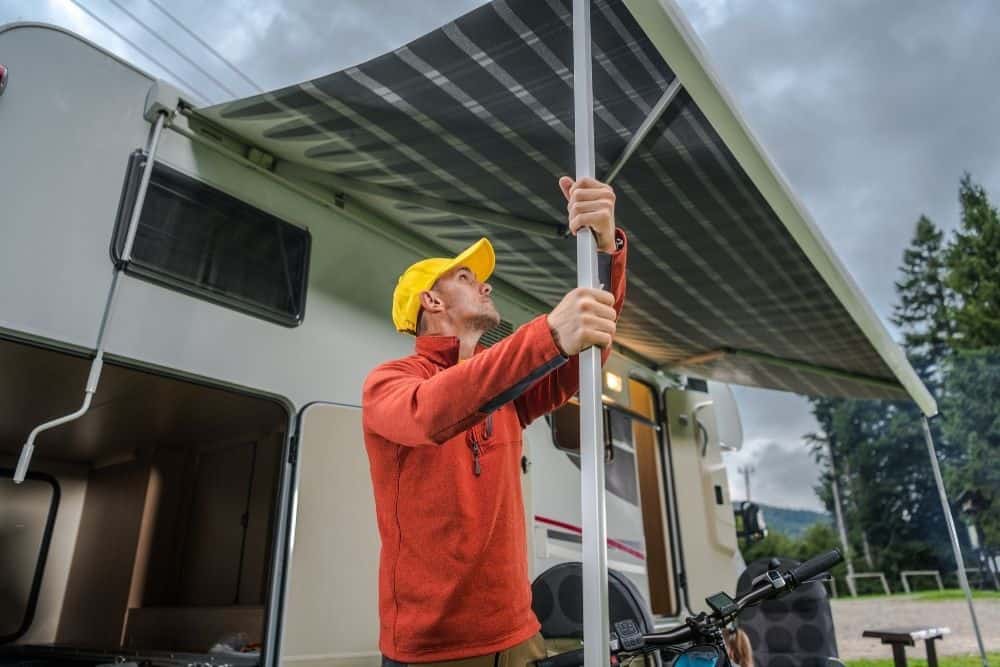Good weather is a frequent expectation whether camping or going on a short road trip. Clear weather and bright sunshine make RVing and maintaining your camper a breeze. Even in the midst of sweltering temperatures, you may relax in the shade of your awning when you’re not on the road.
To ensure that your RV awnings last as long as possible before they need to be replaced, proper care must be taken of them just like the rest of your RV. They don’t need a lot of attention, although mildew is something to keep a close eye on. Tips for cleaning and preventing mildew from harming your RV’s awning are here.
Keeping your awnings clean and dry is the great way to maintain them and keep them in good condition. Depending on the material of your awnings, there are a number of ways to remove mildew from them. If mildew stains are difficult to remove, you can use a soft brush or a light mild detergent and water to remove them.
You can use diluted bleach and a cotton ball to remove mildew stains from your awning and restore its original color. In addition, commercial awning cleaners are excellent in removing mildew and mold that is already present, as well as preventing mildew and mold growth in the future. Vinegar and baking soda mixed with water can be used to destroy microorganisms on the surface if you want a more natural method.
Preventing mildew on your RV awning is as simple as cleaning it regularly. Knowing the kind of awning you have and the material it is constructed of is essential.
Depending on the kind of your RV, you may even have multiple awnings to maintain. Keeping your awnings clean and preventing mildew is easy with a little planning and frequent maintenance. Keep reading to learn how to care for your RV awnings.
What is Mildew?
Mildew is an early-stage mold that is either powdery or downy in texture and turns yellow, black or brown in color as it ages. It also grows on surfaces that are damp.
Cleaning Vinyl Vs Acrylic Awning Fabric
When it comes to removing mildew from a fabric RV awning, the process is a little more complicated than it is for an acrylic one. Both have their benefits and drawbacks.
In comparison to cloth RV awnings, vinyl RV awnings are often made of superior marine-quality vinyl. If you have mildew on your RV awning, the type of material it is made of will determine how easily it can be cleaned and whether or not it will need to be replaced.
Fabric awnings are very resistant to UV rays and dry rapidly, making them ideal for outdoor use. This can help keep mildew at bay before it has a chance to take hold, but it does not guarantee that mildew will not form.
This can be a challenge, and in certain cases impossible, to remove mildew from cloth. Despite the fact that vinyl awnings being mildew resistant, they can still grow mildew if the surface isn’t cleaned correctly or if the air is too humid. While eliminating mildew from vinyl requires a fair amount of effort, it is generally easier to clean than fabric.
Please Note – Humans can have mild to severe symptoms as a result of long-term exposure to toxic mildew.
How To Clean Mold Off RV Awning: Step By Step
We’ve put together a step-by-step tutorial to help you remove mildew and mold from the awning of your RV. In order to keep your awning water and mold resistant between travels, follow these simple techniques to deep clean it.
Check the manufacturer’s instructions that came with your awning because they can differ based on fabric and awning style.
Step 1
The awning on your RV should be fully extended and lowered as far as you possibly can. Using this method will make it much easier to get into and remove mold from hard-to-reach places. Consider using a step stool or short ladder and a long soft handle brush to reach higher spots.
Step 2
Begin by preparing your RV’s mold-killing cleaning products. Mold removers like Star Brite Mold Remover, Valterra’s RV Awning Cleaner, or Borax can be used in industrial blends.
Your RV’s awning should be cleaned with a product that is specifically designed for it. A mold-killing treatment can also be made from stuff that you probably already have.
Dawn dish soap is a popular option because it is powerful but mild.
Bleach may also be used to kill mold and lighten mold spots if you dilute the bleach to the correct concentration.
Baking soda and white vinegar is another go-to cleaning duo that can remove mold, stains, and even tree sap from your awnings.
Clorox Clean-Up spray or Isopropyl alcohol can also be used as a fast solution for killing mold.
Step 3
Use a commercial cleaning product on a tiny area of your awning to ensure that it won’t harm the material. It’s important to remove any loose debris before you begin to wash down the awning (both the top and underside of the material).
Step 4
Premix your solution and apply it to the mold and mildew. Depending on the size of the work area and the sort of mixture you are using, you can either use a soft brush or a spray bottle to apply the product. Ten minutes is a good amount of time to let the solution soak, or as long as is specified in the directions for commercial cleaners.
Step 5
A sponge or soft-bristled brush can next be used to agitate the mold-infested regions. The awning’s protecting coating can be damaged if you use too much force.
Step 6
Rinse the treated areas until mold and solution are completely removed with clean water.
Step 7
Before storing your awning, make sure it is completely dry. The cloth can be stored or treated with (product) to prevent additional mold growth once it has dried. Before storing your awning, let all of the treatment dry completely.
Please Note – Mildew will continue to grow if it is not eliminated.
How Often Should You Clean Your Camper Awning?
To prevent mold and keep your RV camper awning at its best, you should clean it at least twice a year. Properly maintained for RV awnings may acquire mold or mildew if left unattended. Sap, dirt, and water stains can quickly degrade the appearance of your awning.
Every time you wash the outside of your RV, it is a smart idea to perform a light cleaning. To keep mildew from growing on the awning’s top and bottom, simply give it a light wash with your hose.
The awnings must be totally dry before they are closed to prevent the growth of mold and mildew.
Deep cleaning is essential at least once every three months for people who use their RV on a regular basis or who travel frequently. Stains, mold, mildew, and other damage can be caught early with this method.
When cleaning your camper’s awning, always use a light detergent or a specialized awning cleaner. Using a soft-bristled brush with the detergent or cleaning is the best way to get the job done.
Tips For Preventing Mildew From Forming On The Awning
The best method to ensure that your RV awning serves you and your family for many years to come is to prevent mildew from forming.
Dry Them Before Storage
In order to avoid mildew from forming on RV awnings made of both fabric and vinyl, it is essential that they are thoroughly dry before being stored. The most common cause of mildew and mold on both sides of the awning is improper or inadequate drying.
Before rolling it up, make sure it’s completely dry, whether it’s been exposed to mild rain or just a routine cleaning. Awnings used in humid areas are no exception.
Limit Exposure to UV Rays
Make sure your RV awnings are dry before rolling them up when not in use. Too many UV radiation can cause the material to deteriorate and cause the protective coating to wear down more faster than normal.
The protective coating not only keeps your awning in good shape, but it also shields it from water damage. Damage to this layer might lead to the growth of mold or mildew.
Adjust Awning During Heavy Rains
Consider the weather too. In the event of severe rain, ensure the awning is placed in a position that enables the water to drain away from you. Mold and mildew can grow in the center of a pool if water is allowed to pool there for an extended period of time.
Treat Your RV Awning
Protect your RV awning from mold and mildew by using a preventive spray or rub. Better Boat’s cloth RV awnings is an excellent choice.
Star Brite Vinyl Guard can be applied to vinyl RV awnings to prevent mildew from corroding the surface.
Please Note – To make treatment of mildew easier, you should check for mold and mildew on a regular basis.
In Conclusion
RV awnings are an integral feature of your RV that may make your vacations more enjoyable. You’ll be able to reap the benefits of an awning for upcoming years if you maintain it properly.
Awnings should be cleaned at least four times a year, and any mold or mildew should be treated immediately. Awnings can last a long time if you follow these guidelines.


